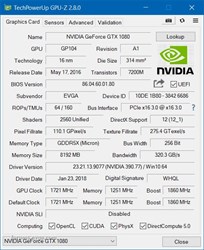Hi everyone,
I've received my
GTX 1080 FTW2 GAMING P/N
08G-P4-6686-KR and as many of you it is equipped with the latest BIOS version
86.04.60.00.80 /
86.04.60.01.80 (master / slave). So
the max memory speed is set by default at 10 GHz effective (1251 MHz in GPU-Z). I've checked the manufacturing date with the S/N and it appears my card was made in November 2017, quite recently.
Don't give up if you purchased such an FTW2 card from new stocks: there is a SOLUTION for updating the BIOS to unlock 11 GHz memory hard-coded! See below my GPU-Z screenshots before and after the update:
.png)
.png) Download the updated BIOS and NVFlash from TechPowerUp website:
Download the updated BIOS and NVFlash from TechPowerUp website: (don't pay attention to the default card picture which is not matching the FTW2)
- EVGA GTX 1080 FTW2 11 GHz master/primary BIOS 86.04.60.00.81 [www.techpowerup.com/vgabios/198855]
- EVGA GTX 1080 FTW2 11 GHz slave/secondary BIOS 86.04.60.01.81 [www.techpowerup.com/vgabios/198856]
- Latest version of NVFlash [www.techpowerup.com/download/nvidia-nvflash]
You can simply use NVFlash in Command Prompt as Admin with the following commands: (64bit system for me)
- nvflash64 --save <filename.rom> to backup your card original BIOS in .ROM format (you can do so quite easily with GPU-Z as well)
- nvflash64 --version <filename.rom> to check both your original BIOS 86.04.60.0*.80 and the updated BIOS 86.04.60.0*.81 have the same "Board ID" and "Subsystem ID" so it is safe to use
- nvflash64 <filename.rom> to flash your card BIOS to the newer version, or restore the original
Now don't forget to disable your "NVIDIA GeForce GTX 1080" in the Device Manager, uninstall the drivers, reboot computer, reinstall the drivers and voilà: enjoy max memory speed at 11 GHz effective (1376 MHz in GPU-Z)
 Remark 1:
Remark 1:As you may have seen in my GPU-Z screenshots, I'm using the slave/secondary BIOS. I want to take credit of the more aggressive fan curves of this BIOS for better cooling performance. The reason I noticed different maximum temperatures reached by the card when benchmarking at full load (with untouched default fan curves):
- Original master BIOS 86.04.60.00.80 (10 GHz) GPU stabilizing at ~70°C
- Original slave BIOS 86.04.60.01.80 (10 GHz) GPU stabilizing at ~60°C
- Updated slave BIOS 86.04.60.01.81 (11 GHz) GPU stabilizing at ~65°C
Of course this is just a hint, not an exhaustive test campaign, but my room temperature was roughly the same at +/- 1°C and I found the trend clear enough. I assume that the 11 GHz memory update remains overclocking, thus dissipating more heat, as for any GTX 1080 card (opposed to the GTX 1080 Ti with memory chips made for that speed). Then it should be treated as deserved: with proper cooling. So be careful and test your card in severe benchmarking after the BIOS update to confirm its stability!
Remark 2:Prior to achieve the above steps, I've been trying for hours and hours to update my BIOS but every time it was not successful! Either the memory was recognized as "Unknown" and stuck at 405 MHz, or some other BIOS at 11 GHz such as 86.04.66.0*.8* were not compatible for flashing my FTW2 card in NVFlash throwing "Board ID mismatch" error impossible to override.
Finally the BIOS versions 86.04.3B.40.81 / 86.04.3B.41.81 provided in post #1 are definitely older revisions for former card stocks! So I guess EVGA should update this post with the appropriate files for every BIOS revision now available on these compatible cards...
Attached Image(s)

